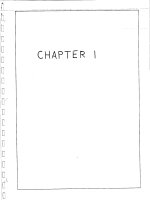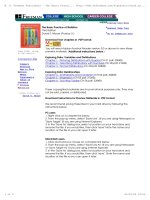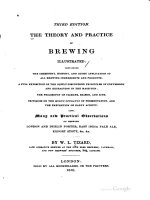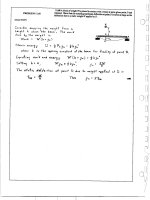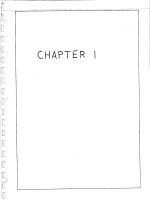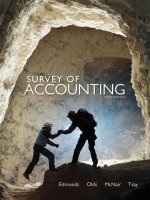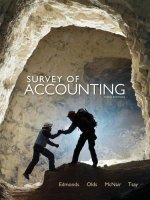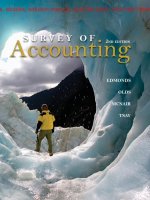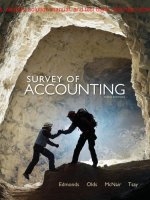Survey of accounting 3rd ed thomas edmonds
Bạn đang xem bản rút gọn của tài liệu. Xem và tải ngay bản đầy đủ của tài liệu tại đây (22.18 MB, 722 trang )
This page intentionally left blank
edm10858_fm_i-xxxiii.indd Page i 12/23/10 4:15 PM user-f494
/204/MHBR210/edm10858_disk1of1/0078110858/edm10858_pagefiles
Third Edition
Survey of Accounting
Thomas P. Edmonds
University of Alabama—Birmingham
Frances M. McNair
Mississippi State University
Philip R. Olds
Virginia Commonwealth University
Bor-Yi Tsay
University of Alabama—Birmingham
edm10858_fm_i-xxxiii.indd Page ii 12/22/10 4:44 PM user-f494
/204/MHBR210/edm10858_disk1of1/0078110858/edm10858_pagefiles
SURVEY OF ACCOUNTING
Published by McGraw-Hill/Irwin, a business unit of The McGraw-Hill Companies, Inc., 1221
Avenue of the Americas, New York, NY 10020. Copyright © 2012, 2010, 2007 by The McGraw-Hill
Companies, Inc. All rights reserved. No part of this publication may be reproduced or distributed
in any form or by any means, or stored in a database or retrieval system, without the prior written
consent of The McGraw-Hill Companies, Inc., including, but not limited to, in any network or other
electronic storage or transmission, or broadcast for distance learning.
Some ancillaries, including electronic and print components, may not be available to customers
outside the United States.
This book is printed on acid-free paper.
1 2 3 4 5 6 7 8 9 0 DOW/DOW 1 0 9 8 7 6 5 4 3 2 1
ISBN 978-0-07-811085-6
MHID 0-07-811085-8
Vice president and editor-in-chief: Brent Gordon
Editorial director: Stewart Mattson
Publisher: Tim Vertovec
Executive editor: Steve Schuetz
Executive director of development: Ann Torbert
Development editor II: Katie Jones
Vice president and director of marketing: Robin J. Zwettler
Marketing director: Brad Parkins
Marketing manager: Michelle Heaster
Vice president of editing, design, and production: Sesha Bolisetty
Lead project manager: Pat Frederickson
Senior buyer: Michael R. McCormick
Designer: Matt Diamond
Senior photo research coordinator: Jeremy Cheshareck
Lead media project manager: Brian Nacik
Media project manager: Joyce J. Chappetto
Typeface: 10/12 Times LT Standard
Compositor: Aptara ®, Inc.
Printer: R. R. Donnelley
Library of Congress Cataloging-in-Publication Data
Survey of accounting / Thomas P. Edmonds . . . [et al.]. — 3rd ed.
p. cm.
Includes index.
ISBN-13: 978-0-07-811085-6 (alk. paper)
ISBN-10: 0-07-811085-8 (alk. paper)
1. Accounting. I. Edmonds, Thomas P.
HF5636.S97 2012
657—dc22
2010050238
www.mhhe.com
edm10858_fm_i-xxxiii.indd Page iii 12/22/10 4:45 PM user-f494
/204/MHBR210/edm10858_disk1of1/0078110858/edm10858_pagefiles
This book is dedicated to our students, whose questions have so frequently caused us to
reevaluate our method of presentation that they have, in fact, become major
contributors to the development of this text.
edm10858_fm_i-xxxiii.indd Page iv 12/22/10 4:45 PM user-f494
/204/MHBR210/edm10858_disk1of1/0078110858/edm10858_pagefiles
NOTE FROM THE AUTHORS
“The alternative
approach to debits and
credits used in the text
to present transactions
the Horizontal Financial
Statement Model is
one that my students
can understand and
can work with in the
classroom and for
testing.”
ROBERT PATTERSON,
PENN STATE-ERIE
“I heartily applaud
the authors’ goal of
providing students
with a concepts-based
approach rather than
a strictly procedurebased approach to
be an important
contribution to
improving accounting
education, one that
appeals to both users
and preparers and
that enables students
to ‘read between
the lines.’”
MICHAEL R. DODGE,
COASTAL CAROLINA
COMMUNITY COLLEGE
“Well written and
easy to read text that
makes the study of
accounting attractive.
The layout of the text,
the colors used, the
additional information
and real-life examples
all increase the appeal
of this text.”
VIVIAN WINSTON,
INDIANA UNIVERSITY
iv
● SUCCESS HAPPENS FOR A REASON
This textbook emerged as a market leader within a short time frame because it provides
a more effective teaching methodology. Here is what sets us apart from our competitors.
● LINKING INDIVIDUAL ACCOUNTING EVENTS
WITH FINANCIAL STATEMENTS
A horizontal financial statements model replaces the accounting equation as the
predominant teaching platform in this text. The model arranges the balance sheet,
income statement and statement of cash flows horizontally across a single line of text
as shown below. The linkage between business events and financial statements is developed by having students record the effects of transaction data directly into the model.
The acquisition of cash from the issue of stock is shown as an example in the following
model (N/A indicates not affected; FA abbreviates financing activities):
Assets 5 Liabilities 1 Stockholders’ Equity
1
N/A
1
Revenue 2 Expense 5 Net Inc.
N/A
N/A
N/A
Cash Flow
1
FA
The statements model enables students to more clearly see how accounting relates to
real-world decision making. Under the traditional approach, students learn to journalize a
series of events and to present summarized information in financial statements. They
never see how individual transactions affect financial statements. When students record
transactions into a statements model, they see a direct link between business events
and financial statements. Most business people think, “if I take this particular action,
how will it affect my financials,” not “if I do these fifteen things how will they be journalized.” Accordingly, the statements model approach provides a learning experience that
is more intuitive and relevant than the one provided by traditional teaching methodology.
● BROAD BASED USER FOCUS
Individual event analysis also broadens the user focus to include internal as well as
external users. Typically, a user oriented approach focuses on external users such as
investors and creditors. Certainly, investors and creditors need to understand how events
affect financial statements. Anticipating future business events and their impact on financial performance is a major factor in evaluating investment opportunities and credit
worthiness. Since business executives (internal users) are dependent on investors and
creditors to provide funding for their operations, they too are interested in how events
affect financial statements. Indeed, executives make few decisions without considering
how those decisions affect “bottom line” financial performance measures. Accordingly,
focusing on how individual transactions affect financial statements encourages students
to develop an internal as well as external user focus.
● A UNIQUE APPROACH TO THE STATEMENT OF CASH FLOWS
We provide comprehensive coverage of the statement of cash flows. Cash flow coverage
starts in Chapter 1 and continues in every chapter throughout the text. With respect
to scope of coverage, this text places the statement of cash flows on parity with the income statement and balance sheet. While the statement of cash flows is critically important in the real world, coverage of the statement is often slighted and usually relegated to
Survey of Accounting
edm10858_fm_i-xxxiii.indd Page v 12/22/10 4:45 PM user-f494
/204/MHBR210/edm10858_disk1of1/0078110858/edm10858_pagefiles
the last chapter in the text. The primary reason for this treatment is that teaching students
to convert accrual accounting data into cash flow is complicated. We remove this complexity by introducing the statement through a highly simplified teaching approach. We begin by teaching students to classify individual cash transactions as financing, investing, or
operating activity. Students then compile the classified transactions into a formal statement of cash flows. Preparing the statement under this direct, transaction by transaction,
approach reduces the learning task to a simple classification scheme.
● THINNING THE TREES TO EXPOSE THE FOREST
We have made a concerted effort to reduced complexity in the early chapters to promote
the development of a strong conceptual foundation. Specifically, we delay coverage of
depreciation, interest computations, and gains and losses. For example, the introduction to depreciation is presented in Chapter 6 thereby allowing students to develop an
understanding of accounting for deferrals without the unnecessary complication of contra
accounts. Likewise, we delay the introduction of gains and losses so that students can
develop an understanding of cash flow from operating activities in a simplified learning
environment. These subjects are not omitted, but rather their introduction is delayed.
● IFRS AND OTHER INTERNATIONAL ACCOUNTING ISSUES
We not only provide comprehensive coverage of Generally Accepted Accounting Principles
(GAAP) but also expose students to International Financial Reporting Standards (IFRS).
Clearly, GAAP is the predominant practice in the United States. However, ever increasing
globalization requires awareness of international standards as well. The book contains textboxes titled “Focus on International Issues”. These boxes include content regarding IFRS and other interesting international topics. Exercises allow the instructor to
reinforce the international content through homework assignments. The textbox approach
allows flexibility in the level of emphasis instructors choose to place on this subject.
● SERVICE COMPANIES EMPHASIZED
We place greater emphasis on service companies. For example, our budgeting chapter
uses a merchandising business while most traditional texts use a manufacturing company. Using a service company is not only more relevant but also simplifies the
learning environment thereby making it easier for students to focus on budgeting
concepts rather than procedural details. This is only one example of our efforts to place
greater emphasis on service companies.
● AN ETHICS FRAMEWORK
We provide extensive coverage of ethics. The accounting scandals of Enron, MCI WorldCom,
HealthSouth and others led to the enactment the Sarbanes-Oxley Act (SOX). SOX places
significant pressure on accountants to identify and eliminate fraudulent reporting. This text
not only provides coverage of appropriate content but also provides a framework for emphasizing ethics throughout the text. This framework is used to solve an ethics case that
is included in the Analyze, Think, and Communicate (ATC) section of end-of-chapter materials for every chapter in the text. Specifically, look at ATC Problem 5 in each chapter. These
cases relate the ethics framework to the specific subjects covered in the each chapter.
Tom Edmonds/Phil Olds/Frances McNair/Bor-Yi Tsay
“Excellent Survey of
Accounting book;
easy to understand
and lots of resources.”
SANDRA OWEN,
INDIANA UNIVERSITY
BLOOMINGTON
“Clear and concise.
The best book I have
seen for use by nonaccounting majors!”
THOMAS CASEY,
DeVRY UNIVERSITY
“I couldn’t recommend
this text too highly to
any of my colleagues.
It literally puts the
‘sizzle’ back into the
teaching process!”
MICHAEL R. DODGE,
COASTAL CAROLINA
COMMUNITY COLLEGE
“This book allowed
me to make
accounting more
interesting and foster
interest where there
was none previously.
More importantly,
it helps students
understand the impact
of transactions on
financial statements
and managerial
decision making.”
GLADYS GOMEZ,
UNIVERSITY OF MARY
WASHINGTON
v
edm10858_fm_i-xxxiii.indd Page vi 12/22/10 4:45 PM user-f494
/204/MHBR210/edm10858_disk1of1/0078110858/edm10858_pagefiles
ABOUT THE AUTHORS
Thomas P. Edmonds
Thomas P. Edmonds, Ph.D., is the Friends and Alumni Professor of Accounting at the University of Alabama
at Birmingham (UAB). Dr. Edmonds has taught in the introductory area throughout his career. He has
coordinated the accounting principles courses at the University of Houston and UAB. He currently teaches
introductory accounting in mass sections and in UAB’s distance learning program. He is actively involved
in the accounting education change movement. He has conducted more than 50 workshops related to
teaching introductory accounting during the last decade. Dr. Edmonds has received numerous prestigious teaching awards including the Alabama Society of CPAs Outstanding Educator Award and the UAB
President’s Excellence in Teaching Award. Dr. Edmonds’s current research is education based. He has
written articles that have appeared in many publications including the Accounting Review, Issues in
Accounting Education, Journal of Accounting Education, and Advances in Accounting Education. Dr. Edmonds
has been a successful entrepreneur. He has worked as a management accountant for a transportation
company and as a commercial lending officer for the Federal Home Loan Bank. Dr. Edmonds began his
academic training at Young Harris Community College. His Ph.D. degree was awarded by Georgia State
University. Dr. Edmonds’s work experience and academic training have enabled him to bring a unique
perspective to the classroom.
Philip R. Olds
Professor Olds is Associate Professor of Accounting at Virginia Commonwealth University (VCU). He serves
as the coordinator of the introduction to accounting courses at VCU. Professor Olds received his A.S. degree from Brunswick Junior College in Brunswick, Georgia (now Costal Georgia Community College). He
received a B.B.A. in accounting from Georgia Southern College (now Georgia Southern University) and his
M.P.A. and Ph.D. degrees are from Georgia State University. After graduating from Georgia Southern, he
worked as an auditor with the U.S. Department of Labor in Atlanta, Georgia. A former CPA in Virginia,
Professor Olds has published articles in various professional journals and presented papers at national
and regional conferences. He also served as the faculty adviser to the VCU chapter of Beta Alpha Psi for
five years. In 1989, he was recognized with an Outstanding Faculty Vice-President Award by the national
Beta Alpha Psi organization. Professor Olds has received both the Distinguished Teaching Award and the
Distinguished Service Award from the VCU School of Business.
Frances M. McNair
Frances M. McNair holds the KPMG Peat Marwick Professorship in Accounting at Mississippi State University (MSU). She has been involved in teaching principles of accounting for the past 12 years and currently
serves as the coordinator for the principles of accounting courses at MSU. She joined the MSU faculty in
1987 after receiving her Ph.D. from the University of Mississippi. The author of various articles that have
appeared in the Journal of Accountancy, Management Accounting, Business and Professional Ethics
Journal, The Practical Accountant, Taxes, and other publications, she also coauthored the book The Tax
Practitioner with Dr. Denzil Causey. Dr. McNair is currently serving on committees of the American Taxation
Association, the American Accounting Association, and the Institute of Management Accountants as well
as numerous School of Accountancy and MSU committees.
vi
Survey of Accounting
edm10858_fm_i-xxxiii.indd Page vii 12/22/10 4:45 PM user-f494
/204/MHBR210/edm10858_disk1of1/0078110858/edm10858_pagefiles
Bor-Yi Tsay
Bor-Yi Tsay, Ph.D., CPA is Professor of Accounting at the University of Alabama at Birmingham (UAB)
where he has taught since 1986. He has taught principles of accounting courses at the University of
Houston and UAB. Currently, he teaches an undergraduate cost accounting course and an MBA strategic
cost management course. Dr. Tsay received the 1996 Loudell Ellis Robinson Excellence in Teaching
Award. He has also received numerous awards for his writing and publications including the John L.
Rhoads Manuscripts Award, John Pugsley Manuscripts Award, Van Pelt Manuscripts Award, and three
certificates of merits from the Institute of Management Accountants. His articles have appeared in Journal
of Accounting Education, Management Accounting, Journal of Managerial Issues, CPA Journal, CMA Magazine, Journal of Systems Management, and Journal of Medical Systems. He currently serves as a member of the board of the Birmingham Chapter, Institute of Management Accountants. He is also a member
of the American Institute of Certified Public Accountants and Alabama Society of Certified Public Accountants. Dr. Tsay received a B.S. in agricultural economics from National Taiwan University, an M.B.A. with
a concentration in accounting from Eastern Washington University, and a Ph.D. in accounting from the
University of Houston.
Tom Edmonds/Phil Olds/Frances McNair/Bor-Yi Tsay
vii
edm10858_fm_i-xxxiii.indd Page viii 12/22/10 4:45 PM user-f494
/204/MHBR210/edm10858_disk1of1/0078110858/edm10858_pagefiles
HOW DOES THE BOOK
edm10858_ch05_156-199.indd Page 157 11/23/10 2:55 PM user-f494
/204/MHBR214/hug_disk1of1/0078112656/hug12656_pagefiles
Real-World Examples
The text provides a variety
of thought-provoking, realworld examples of financial
and managerial accounting as an essential part of
the management process.
There are descriptions of
accounting practices from
Zales. These companies
are highlighted in blue in
the text.
The Curious Accountant
Suppose the U.S. government purchases $10 million of
fuel from ExxonMobil. Assume the government offers
to pay for the fuel on the day it receives it from Exxon
(a cash purchase) or 30 days later (a purchase on
account).
Assume that Exxon is absolutely sure the government will pay its account
due. Do
think Exxon
edm10858_ch05_156-199.indd
Page when
159 11/22/10
5:48you
PM user-f494
should care whether the government
pays for the goods
/204/MHBR210/edm10858_disk1of1/0078110858/edm10858_pagefiles
upon delivery or 30 days later? Why? (Answers on page 159.)
The Curious Accountant
Each chapter opens with a
short vignette that sets the
stage and helps pique student
interest. These pose a
question about a real-world
accounting issue related to
the topic of the chapter. The
answer to the question appears in a separate sidebar
a few pages further into the
chapter.
Exxon would definitely prefer to
Answers to The Curious Accountant
make the sale to the government in
cash rather than on account. Even
tthough it may be certain to collect its
accounts receivable, the sooner Exxon gets its cash, the sooner the cash can be reinvested.
The interest cost related to a small account receivable of $50 that takes 30 days to collect may seem
immaterial; at 4 percent, the lost interest amounts to less than $.20. However, when one considers that Exxon
had approximately $27.6 billion of accounts receivable, the cost of financing receivables for a real-world
company becomes apparent. At 4 percent, the cost of waiting 30 days to collect $27.6 billion of cash is $90.7
million ($27.6 billion 3 .04 3 [30 4 365]). For one full year, the cost to Exxon would be more than $1.1 billion
($27.6 billion
In 7:10
2009,
took Exxon
edm10858_ch06_200-239.indd
Page 3
2170.04).
11/22/10
PMituser-f494
approximately 32 days to/204/MHBR210/edm10858_disk1of1/0078110858/edm10858_pagefiles
collect its accounts receivable, and the
weighted-average interest rate on its debt was approximately 4 percent.
Focus on International Issues
These boxed inserts expose students to international issues in
accounting.
FOCUS ON INTERNATIONAL ISSUES
RESEARCH AND DEVELOPMENT VS. RESEARCH OR
DEVELOPMENT
For many years some thought the companies that followed U.S.
GAAP were at a disadvantage when it came to research and development (R&D) costs, because these companies had to immediately
expense such cost, while the accounting rules of some other countries allowed R&D cost to be capitalized. Remember, recording costs
as an asset—capitalizing it—means that net income is not immediately reduced. The global movement toward using IFRS is reducing,
but not eliminating, the different accounting treatments for R&D.
Like U.S. GAAP, IFRS require research costs to be expensed,
but they allow development costs to be capitalized. This IFRS rule
itself can present challenges, because sometimes it is not clear
where research ends and development begins. Basically, once research has produced a product, patent, and so forth, that the company believes will result in a revenue generating outcome, any additional costs to get it ready for market are development costs.
“The Curious Accountant and Real-World Examples, all make the text better
and would make it a pleasure to teach from.”
VIVIAN WINSTON,
INDIANA UNIVERSITY
viii
Survey of Accounting
edm10858_fm_i-xxxiii.indd Page ix 12/22/10 4:45 PM user-f494
/204/MHBR210/edm10858_disk1of1/0078110858/edm10858_pagefiles
MOTIVATE STUDENTS?
Check Yourself
CHECK YOURSELF 2.1
During 2012, Anwar Company earned $345,000 of revenue on account and collected $320,000
cash from accounts receivable. Anwar paid cash expenses of $300,000 and cash dividends of
$12,000. Determine the amount of net income Anwar should report on the 2012 income statement and the amount of cash flow from operating activities Anwar should report on the 2012
statement of cash flows.
Answer Net income is $45,000 ($345,000 revenue 2 $300,000 expenses). The cash flow
from operating activities is $20,000, the amount of revenue collected in cash from customers (accounts receivable) minus the cash paid for expenses ($320,000 2 $300,000).
Dividend payments
are classified
financing activities and do not affect /204/MHBR210/edm10858_disk1of1/0078110858/edm10858_pagefiles
the determiedm10858_ch03_086-123.indd
Page 101 11/16/10
10:03 PMas
user-f494
nation of either net income or cash flow from operating activities.
These short question/answer
features occur at the end of
each main topic and ask
students to stop and think
about the material just covered.
The answer follows to provide
immediate feedback before
students go on to a new topic.
Reality Bytes
REALITY BYTES
This feature provides examples
or expansions of the topics
presented by highlighting companies and showing how they
use the accounting concepts
discussed in the chapter to
make business decisions.
“Closed for Inventory Count” is a sign you frequently see on retail stores sometime during the
month of January. Even if companies use a perpetual inventory system, the amount of inventory on hand may be unknown because of lost, damaged, or stolen goods. The only way to
determine the amount of inventory on hand is to count it. Why count it in January? Christmas
shoppers and many after-Christmas sales shoppers are satiated by mid-January, leaving the
stores low on both merchandise and customers. Accordingly, stores have less merchandise
to count and “lost sales” are minimized during January. Companies that do not depend on
seasonal sales (e.g., a plumbing supplies wholesale business) may choose to count inventory
at some other time during the year. Counting inventory is not a revenue-generating activity; it
is a necessary evil that should be conducted when it least disrupts operations.
edm10858_ch05_156-199.indd Page 179 11/23/10 2:56 PM user-f494
/204/MHBR214/hug_disk1of1/0078112656/hug12656_pagefiles
A Look Back/A Look Forward
A Look Back <<
edm10858_ch02_044-085.indd Page 67 11/15/10 9:55 PM user-f494
Students need a roadmap to
make sense of where the
chapter topics fit into the
whole picture. A Look Back
reviews the chapter material
and a Look Forward introduces
new material to come in the
next chapter.
/204/MHBR210/edm10858_disk1of1/0078110858/edm10858_pagefiles
We first introduced accounting for receivables in Chapter 2. This chapter presented additional complexities related to accounts receivable, such as the allowance method of
accounting for uncollectible accounts. The allowance method improves matching of expenses with revenues. It also provides a more accurate measure of the value of accounts
receivable on the balance sheet.
A Look Forward >>
Chapters 1 and 2 focused on businesses that generate revenue by providing services to
their customers. Examples of these types of businesses include consulting, real estate
sales, medical services, and legal services. The next chapter introduces accounting practices for businesses that generate revenue by selling goods. Examples of these companies include Wal-Mart, Circuit City, Office Depot, and Lowes.
“The Reality Bytes and Check Yourself sections in the chapters
enhance the presentation.”
ROBERT PATTERSON,
PENN STATE-ERIE
“I like the Check yourself examples.”
BRUCE DARLING,
UNIVERSITY OF OREGON
Tom Edmonds/Phil Olds/Frances McNair/Bor-Yi Tsay
ix
edm10858_fm_i-xxxiii.indd Page x 12/22/10 4:45 PM user-f494
/204/MHBR210/edm10858_disk1of1/0078110858/edm10858_pagefiles
HOW ARE CHAPTER
edm10858_ch02_044-085.indd Page 67 11/15/10 9:55 PM user-f494
/204/MHBR210/edm10858_disk1of1/0078110858/edm10858_pagefiles
Regardless of the instructional approach, there is no shortcut to learning accounting.
Students must practice to master basic accounting concepts. The text includes a prodigious supply of practice materials and exercises and problems.
A step-by-step audio-narrated series of slides is provided on the text
website at www.mhhe.com/edmondssurvey3e
www.mhh
ed
om/ mon
e.c
sur vey3e
ds
Self-Study Review
Problem
These sections offer
SELF-STUDY REVIEW PROBLEM
problems and solutions
of major chapter
Gifford Company experienced the following accounting events during 2012.
edm10858_ch02_044-085.indd Page 79 11/15/10 9:55 PM user-f494
/204/MHBR210/edm10858_disk1of1/0078110858/edm10858_pagefiles
concepts.
1. Started operations on January 1 when it acquired $20,000 cash by issuing common
stock.
Earned $18,000 of revenue on account.
On March 1 collected $36,000 cash as an advance for services to be performed in the future.
Paid cash operating expenses of $17,000.
Paid a $2,700 cash dividend to stockholders.
On December 31, 2012, adjusted the books to recognize the revenue earned by providing
services related to the advance described in Event 3. The contract required Gifford to provide
services for a one-year period starting March 1.
7. Collected $15,000 cash from accounts receivable.
2.
3.
4.
5.
6.
y
Exercise and
Problem Sets
• Check figures
The figures provide a
quick reference for
students to check on
their progress in solving
the problem.
• Excel
Many exercises and
problems can be solved
using the Excel™
spreadsheet templates
contained on the text’s
Online Learning Center.
A logo appears in the
margins next to these
exercises and problems
for easy identification.
p
Assets
Event
No.
1
5
Liabilities
1
Stockholders’
Equity
Rev. 2 Exp. 5 Net Inc.
Cash Flows
NA 2 NA 5
25,000 FA
Accts.
Accts.
Unearn.
Com.
Ret.
Cash 1 Rec. 1 Supp. 5 Pay. 1 Rev. 1 Stk. 1 Earn.
25,000 1
NA
1
NA
5
NA
1
NA
1 25,000 1
NA
NA
Problem 2-28 Effect of deferrals on financial statements: three separate single-cycle examples
Required
a. On February 1, 2012, Heider, Inc., was formed when it received $80,000 cash from the issue
of common stock. On May 1, 2012, the company paid $60,000 cash in advance to rent office
space for the coming year. The office space was used as a place to consult with clients. The
consulting activity generated $120,000 of cash revenue during 2012. Based on this information alone, record the events and related adjusting entry in the general ledger accounts under
the accounting equation. Determine the amount of net income and cash flows from operating activities for 2012.
b. On January 1, 2012, the accounting firm of Bonds & Associates was formed. On August 1,
2012, the company received a retainer fee (was paid in advance) of $30,000 for services to be
performed monthly during the next 12 months. Assuming that this was the only transaction
completed in 2012, prepare an income statement, statement of changes in stockholders’
equity, balance sheet, and statement of cash flows for 2012.
c. Edge Company had $2,200 of supplies on hand on January 1, 2012. Edge purchased $7,200
of supplies on account during 2012. A physical count of supplies revealed that $900 of supplies was on hand as of December 31, 2012. Determine the amount of supplies expense that
should be recognized in the December 31, 2012 adjusting entry. Use a financial statements
model to show how the adjusting entry would affect the balance sheet, income statement,
and statement of cash flows.
Problem 2-29 Effect of adjusting entries on the accounting equation
CHECK FIGURES
a. Net Income: $80,000
b. Net Income: $12,500
LO 2
Required
Each of the following independent events requires a year-end adjusting entry. Show how each
event and its related adjusting entry affect the accounting equation. Assume a December 31 closing date. The first event is recorded as an example.
x
CHECK FIGURE
b. adjustment amount: $1,250
Survey of Accounting
edm10858_fm_i-xxxiii.indd Page xi 12/22/10 4:45 PM user-f494
/204/MHBR210/edm10858_disk1of1/0078110858/edm10858_pagefiles
edm10858_ch06_200-239.indd Page 237 11/22/10 7:10 PM user-f494
/204/MHBR210/edm10858_disk1of1/0078110858/edm10858_pagefiles
CONCEPTS REINFORCED?
Analyze, Think, Communicate (ATC)
Each chapter includes an innovative
section entitled Analyze, Think, Communicate (ATC). This section contains:
• Business application cases related to
the annual report for Target Company
ANALYZE, THINK, COMMUNICATE
ATC 6-1
Understanding real-world annual reports
Use the Target Corporation’s annual report in Appendix B to answer the following questions.
What method of depreciation does Target use?
What types of intangible assets does Target have?
What are the estimated lives that Target uses for the various types of long-term assets?
As of January 30, 2010, what is the original cost of Target’s: Land; Buildings and improvements; and Fixtures and equipment (see the footnotes)?
e. What was Target’s depreciation expense and amortization expense for 2009 (see the
footnotes)?
a.
b.
c.
d.
ATC 6-2
• Writing Assignments
Business Applications Case
Required
Group Assignment
Different depreciation methods
Sweet’s Bakery makes cakes, pies, and other pastries that it sells to local grocery stores. The company experienced the following transactions during 2012.
1.
2.
3.
4.
5.
• Group Exercises
Started business by acquiring $60,000 cash from the issue of common stock.
Purchased bakery equipment for $46,000 with a four year life and a $6,000 salvage value.
Had cash sales in 2012 amounting to $42,000.
Paid $8,200 of cash for supplies which were all used during the year to make baked goods.
Paid other operating expenses of $12,000 for 2012.
Required
a. Organize the class into two sections and divide each section into groups of three to five
students. Assign each section a depreciation method: straight-line or double-decliningbalance.
• Ethics Cases
Group Task
Prepare an income statement and a balance sheet using the preceding information and the
depreciation method assigned to your group.
Class Discussion
b. Have a representative of each section put its income statement on the board. Are there differences in net income? How will these differences in the amount of depreciation expense
change over the life of the equipment?
• Internet Assignments
ATC 6-3
• Excel Spreadsheet Applications
• Real Company Examples
Research Assignment Comparing Microsoft’s and Intel’s operational assets
Companies in different industries often use different proportions of current versus long-term assets to accomplish their business objective. The technology revolution resulting from the silicon
microchip has often been led by two well-known companies: Microsoft and Intel. Although often thought of together, these companies are really very different. Using either the most current
Forms 10-K or annual reports for Microsoft Corporation and Intel Corporation, complete the
requirements below. To obtain the Forms 10-K, use either the EDGAR system following the instructions in Appendix A or the company’s website. Microsoft’s annual report is available on its
website; Intel’s annual report is its Form 10-K.
Target Corporation
“I like the real life examples; I like the Analyze, Think and Communicate.”
DEBBIE GAHR, WAUKESHA COUNTY TECHNICAL COLLEGE
Tom Edmonds/Phil
Edmonds/Frances
Olds/Frances
McNair/Phil
McNair/Bor-Yi
Olds
Tsay
xi
edm10858_fm_i-xxxiii.indd Page xii 12/22/10 4:45 PM user-f494
/204/MHBR210/edm10858_disk1of1/0078110858/edm10858_pagefiles
WHAT WE DID
We have reorganized the content to more closely follow a traditional balance sheet
sequencing approach. Specifically, the first three chapters introduce the accounting
cycle for service and merchandising businesses. Thereafter, topics are presented in the
order they normally appear in a balance sheet with accounting for assets being discussed
first, followed by accounting for liabilities, and finally accounting for equity. We moved
topics associated with corporate governance from Chapter 2 into Chapter 4. Chapter 4
now includes coverage of Accounting for Cash, Internal Controls, and Ethics. Accounting
for Inventory Cost Flow was moved from Chapter 4 into Chapter 5. Chapter 5 now
includes Accounting for Receivables and Inventory Cost Flow. A comparative table of
contents is shown below:
Table of Contents for the Second Edition
Table of Contents for the Third Edition
Chapter 1
Chapter 2
Chapter 3
Chapter 4
Chapter 5
Chapter 6
Chapter 7
Chapter 8
Chapter 9
Chapter 10
Chapter 11
Chapter 1
Chapter 2
Chapter 3
Chapter 4
Chapter 5
Chapter 6
Chapter 7
Chapter 8
Chapter 9
Chapter 10
Chapter 11
Chapter 12
Chapter 13
Chapter 14
Chapter 15
Chapter 16
An Introduction to Accounting
Understanding the Accounting Cycle
Accounting for Merchandising Businesses
Accounting for Inventories and Cash
Accounting for Receivables
Accounting for Long-Term Operational Assets
Accounting for Liabilities
Proprietorships, Partnerships, and Corporations
Financial Statement Analysis
An Introduction to Managerial Accounting
Cost Behavior, Operating Leverage, and
Profitability Analysis
Cost Accumulation, Tracing and Allocation
Relevant Information for Special Decisions
Planning for Profit and Cost Control
Performance Evaluation
Planning for Capital Investments
Chapter 12
Chapter 13
Chapter 14
Chapter 15
Chapter 16
An Introduction to Accounting
Understanding the Accounting Cycle
Accounting for Merchandising Businesses
Internal Controls, Accounting for Cash, and Ethics
Accounting for Receivables and Inventory Cost Flow
Accounting for Long-Term Operational Assets
Accounting for Liabilities
Proprietorships, Partnerships, and Corporations
Financial Statement Analysis
An Introduction to Managerial Accounting
Cost Behavior, Operating Leverage, and
Profitability Analysis
Cost Accumulation, Tracing and Allocation
Relevant Information for Special Decisions
Planning for Profit and Cost Control
Performance Evaluation
Planning for Capital Investments
To reduce duplication we consolidated coverage of financial ratios into Chapter 9
Financial Statement Analysis. While we continue to cover statement interpretation
issues in each chapter, financial ratios are presented in Chapter 9. Removing coverage of financial ratios from each chapter provided additional space that has allowed
us to add coverage of topics. For example, we added basic coverage of auditing practices in Chapter 4. In addition, we added coverage of bond discounts and premiums
in Chapter 7. The straight-line method of amortizing discounts and premiums is covered in the main body of the text and the effective interest rate method is covered in
the chapter appendix. Also, we added coverage of manufacturing costs flow through
raw materials, work-in-process, and finished goods inventory in Chapter 10. Finally,
we revised the ATC end of chapter materials to contain a consistent set of cases and
exercises. Specifically, the ATC section now includes a business application case, a
group assignment, a research assignment, a writing assignment, and an ethics case
in each chapter.
xii
Survey of Accounting
edm10858_fm_i-xxxiii.indd Page xiii 12/22/10 4:45 PM user-f494
/204/MHBR210/edm10858_disk1of1/0078110858/edm10858_pagefiles
TO MAKE IT BETTER!
SPECIFIC CHAPTER CHANGES
Chapter 1 An Introduction to Accounting
• Added a discussion of the role of accounting in society.
• More clearly described the relationship between assets and expenses.
• Updated Curious Accountant with new scenario including high-profile companies and
products.
• Updated Focus on International Issues textbox.
• Revised Reality Bytes with new content about a new high-profile company and products.
• Updated Check Yourself text box content to reflect current dates and relevant scenarios.
• Updated exercises, problems, and cases.
Chapter 2 Understanding the Accounting Cycle
• Reorganized Exhibit 2.1 and 2.7 to include transaction data.
• Updated Curious Accountant with current data from real-world companies.
• Removed content related to corporate governance and ethics. This content now appears
in Chapter 4 with related issues such as internal control.
• Updated Check Yourself text box content to reflect current dates and relevant scenarios.
• Updated exercises, problems, and cases.
Chapter 3 Accounting for Merchandising Businesses
•
•
•
•
Updated Curious Accountant with current data from real-world companies.
Revised Reality Bytes with new content about a new scenario, company and products.
Updated Check Yourself text box content to reflect current dates and relevant scenarios.
Updated exercises, problems, and cases.
Chapter 4 Accounting for Internal Controls, Accounting for
Cash, and Ethics
• Accounting for inventory cost flow has been moved from this chapter and placed in
what is now Chapter 5 of the revised third edition text. Cooperate governance and
ethics content have been moved into Chapter 4. These changes are in keeping with a
balance sheet sequence of content presentation. Specifically, we cover internal control,
ethics, and accounting for cash in Chapter 4. Coverage of accounts receivable and a
discussion of inventory cost flow now appear in Chapter 5. Thereafter, we continue to
discuss topics in the order they would appear in a customary top down reading of a
balance sheet.
• Added coverage of The Committee of Sponsoring Organizations of the Treadway Commission (COSO) framework for internal controls.
• Added coverage of the external audit function and the types of audit opinions.
• Replaced Curious Accountant content with new scenario including high-profile companies and characters.
• Added a new Reality Bytes textbox.
• Updated Check Yourself text box content to reflect current dates and relevant scenarios.
• Updated exercises, problems, and cases.
Tom Edmonds/Phil Olds/Frances McNair/Bor-Yi Tsay
xiii
edm10858_fm_i-xxxiii.indd Page xiv 12/22/10 4:45 PM user-f494
/204/MHBR210/edm10858_disk1of1/0078110858/edm10858_pagefiles
Chapter 5 Accounting for Receivables and Inventory
Cost Flow
• Added a discussion of inventory cost flow. This content was discussed in Chapter 4 of
the previous edition of the text. The move was made to promote a consistent pattern
of presenting information in the sequence it normally is covered in a formal balance
sheet. Coverage of accounting for cash which was previously included in Chapter 5
has been moved forward to Chapter 4.
• Updated Curious Accountant with current data from real-world companies.
• Added a new Focus on International Issues textbox.
• Revised Reality Bytes with new content about a new high-profile company and products.
• Updated Check Yourself text box content to reflect current dates and relevant scenarios.
• Updated exercises, problems, and cases.
Chapter 6 Accounting for Long-Term Operational Assets
• Updated Curious Accountant with current data from real-world companies.
• Replaced Focus on International Issues with new scenario related to international financial reporting standards (IFRS).
• Revised Reality Bytes with new content about a new high-profile company and products.
• Updated Check Yourself text box content to reflect current dates and relevant scenarios.
• Updated exercises, problems, and cases.
Chapter 7 Accounting for Liabilities
• Added coverage of straight-ling amortization of discounts and premiums.
• Added a chapter appendix covering the effective interest rate method of amortization
of discounts and premiums.
• Replaced Curious Accountant content with new scenario including high-profile companies and products.
• Replaced Focus on International Issues with new scenario related to international financial reporting standards (IFRS).
• Revised Reality Bytes with new content about a new high-profile company and products.
• Updated Check Yourself text box content to reflect current dates and relevant scenarios.
• Updated exercises, problems, and cases.
Chapter 8 Proprietorships, Partnerships, and Corporations
• Updated Curious Accountant with current data from real-world companies.
• Replaced Focus on International Issues with new scenario related to international financial reporting standards (IFRS).
• Revised Reality Bytes with new content about a new high-profile company and products.
• Updated Check Yourself text box content to reflect current dates and relevant scenarios.
• Updated exercises, problems, and cases.
Chapter 9 Financial Statement Analysis
• Replaced Curious Accountant content with new scenario including high-profile companies and products.
• Revised Reality Bytes with new content about a new high-profile company and products.
• Updated Check Yourself text box content to reflect current dates and relevant scenarios.
• Updated exercises, problems, and cases.
xiv
Survey of Accounting
edm10858_fm_i-xxxiii.indd Page xv 12/22/10 4:45 PM user-f494
/204/MHBR210/edm10858_disk1of1/0078110858/edm10858_pagefiles
Chapter 10 An Introduction to Managerial Accounting
• Added coverage of manufacturing cost flow including raw materials inventory, work-inprocess inventory and finished goods inventory. Coverage includes preparation of the
schedule of cost of goods manufactured and sold.
• Updated Curious Accountant with new scenario including high-profile companies and
products.
• Updated Focus on International Issues textbox.
• Revised Reality Bytes with new content about a new high-profile company and products.
• Updated Check Yourself text box content to reflect current dates and relevant scenarios.
• Updated exercises, problems, and cases. Added exercises and problems associated
with the schedule of cost of goods manufactured and sold.
Chapter 11 Cost Behavior, Operating Leverage,
and Profitability Analysis
• Replaced Curious Accountant content with new scenario including high-profile companies and products.
• Replaced Focus on International Issues content with new subject matter.
• Replaced Reality Bytes with new content about a new high-profile companies and products.
• Updated Check Yourself text box content to reflect current dates and relevant scenarios.
• Updated exercises, problems, and cases.
Chapter 12 Cost Accumulation, Tracing, and Allocation
•
•
•
•
Replaced Focus on International Issues content with new subject matter.
Updated Reality Bytes.
Updated Check Yourself text box content to reflect current dates and relevant scenarios.
Updated exercises, problems, and cases.
Chapter 13 Relevant Information for Special Decisions
•
•
•
•
Updated Curious Accountant.
Updated Focus on International Issues.
Updated Check Yourself text box content to reflect current dates and relevant scenarios.
Updated exercises, problems, and cases.
Chapter 14 Planning for Profit and Cost Control
•
•
•
•
Updated Curious Accountant.
Updated Reality Bytes.
Updated Check Yourself text box content to reflect current dates and relevant scenarios.
Updated exercises, problems, and cases.
Chapter 15 Performance Evaluation
• Replaced Curious Accountant content with new scenario including high-profile companies and products.
• Updated Check Yourself text box content to reflect current dates and relevant scenarios.
• Updated exercises, problems, and cases.
Chapter 16 Planning for Capital Investments
•
•
•
•
•
Updated Curious Accountant.
Updated Focus on International Issues.
Updated Reality Bytes.
Updated Check Yourself text box content to reflect current dates and relevant scenarios.
Updated exercises, problems, and cases.
Tom Edmonds/Phil Olds/Frances McNair/Bor-Yi Tsay
xv
edm10858_fm_i-xxxiii.indd Page xvi 12/22/10 4:45 PM user-f494
/204/MHBR210/edm10858_disk1of1/0078110858/edm10858_pagefiles
HOW CAN TECHNOLOGY
● McGRAW-HILL’s CONNECT TM ACCOUNTING
Less Managing.
More Teaching.
accounting Greater Learning.
McGraw-Hill’s Connect™ Accounting is an online assignment and assessment solution that connects
students with the tools and resources they’ll need
to achieve success.
McGraw-Hill’s Connect Accounting helps prepare students for their future by enabling faster
learning, more efficient studying, and higher retention of knowledge.
Connect Accounting offers a number of powerful
tools and features to make managing assignments
easier, so instructors can spend more time teaching. With Connect Accounting, students can engage
with their coursework anytime and anywhere, making
the learning process more accessible and efficient.
Connect Accounting offers you the features described
below.
Simple Assignment Management
With Connect Accounting, creating assignments is
easier than ever, so you can spend more time teaching and less time managing. The assignment management function enables you to:
• Create and deliver assignments easily with selectable end-of-chapter questions and test bank
items.
• Streamline lesson planning, student progress reporting, and assignment grading to make classroom management more efficient than ever.
• Go paperless with the eBook and online submission and grading of student assignments.
Smart Grading
When it comes to studying, time is precious.
Connect Accounting helps students learn more
efficiently by providing feedback and practice material when they need it, where they need it. When it
comes to teaching, your time also is precious. The
grading function enables you to:
• Have assignments scored automatically, giving
students immediate feedback on their work and
side-by-side comparisons with correct answers.
xvi
• Access and review each response; manually
change grades or leave comments for students to
review.
Instructor Library
The Connect Accounting Instructor Library is your
repository for additional resources to improve student engagement in and out of class. You can select and use any asset that enhances your lecture.
The Connect Accounting Instructor Library for
Edmonds 3e includes:
•
•
•
•
•
eBook
PowerPoint files
Instructor’s and Solutions Manuals
Test Bank
Excel Spreadsheet Solutions
Student Library
The Connect Accounting Student Library is the place
for students to access additional resources. The
Student Library provides:
• Quick access to lectures, practice materials,
eBook, and more.
• Instant practice material and study questions,
easily accessible on the go.
Student Progress Tracking
Connect Accounting keeps instructors informed
about how each student, section, and class is performing, allowing for more productive use of lecture
and office hours. The progress-tracking function
enables you to:
• View scored work immediately and track individual or group performance with assignment and
grade reports.
• Access an instant view of student or class performance relative to learning objectives.
• Collect data and generate reports required by
many accreditation organizations, such as AACSB
and AICPA.
Survey of Accounting
edm10858_fm_i-xxxiii.indd Page xvii 12/22/10 5:45 PM user-f494
/204/MHBR210/edm10858_disk1of1/0078110858/edm10858_pagefiles
HELP STUDENTS SUCCEED?
Tegrity
Increase the attention paid to lecture discussion by
decreasing the attention paid to note taking. For a
minimal charge Tegrity offers new ways for students
to focus on the in-class discussion, knowing they
can revisit important topics later. Tegrity enables
you to:
• Record and distribute your lecture with a click of a
button.
• Record and index PowerPoint presentations and
anything shown on your computer so it is easily
searchable, frame by frame.
• Offer access to lectures anytime and anywhere by
computer, iPod, or mobile device.
• Increase intent listening and class participation
by easing students’ concerns about note-taking.
Tegrity will make it more likely you will see students’ faces, not the tops of their heads.
McGraw-Hill’s Connect ™ Plus Accounting
McGraw-Hill’s reinvents the textbook learning experience for the modern student with Connect™ Plus
Tom Edmonds/Phil Olds/Frances McNair/Bor-Yi Tsay
Accounting. A seamless integration of an eBook and
Connect Accounting, Connect Plus Accounting provides all of the Connect Accounting features plus the
following:
• An integrated eBook, allowing for anytime, anywhere access to the textbook.
• Dynamic links between the problems or questions you assign to your students and the location in the eBook where that problem or question
is covered.
• A powerful search function to pinpoint and connect key concepts in a snap.
In short, Connect Accounting offers you and your
students powerful tools and features that optimize
your time and energies, enabling you to focus on
course content, teaching, and student learning.
Connect Accounting also offers a wealth of content
resources for both instructors and students. This
state-of-the-art, thoroughly tested system supports
you in preparing students for the world that awaits.
For more information about Connect Accounting,
go to www.mcgrawhillconnect.com, or contact your
local McGraw-Hill representative.
xvii
edm10858_fm_i-xxxiii.indd Page xviii 12/22/10 4:45 PM user-f494
Online Learning Center (OLC)
www.mhhe.com/edmondssurvey3e
More and more students are studying online. That’s
why we offer an Online Learning Center (OLC) that
follows Survey of Accounting 3e chapter by chapter. The OLC includes the following:
• Excel Spreadsheets
• Interactive Quizzes
• PowerPoint Slides
CourseSmart.com
CourseSmart is a new
way to find and buy
eTextbooks. At CourseSmart you can save up to 45 percent off the cost
of a printed textbook, reduce your impact on the
environment, and gain access to powerful web
tools for learning. CourseSmart has the largest
selection of eTextbooks available anywhere, offering thousands of the most commonly adopted
textbooks from a wide variety of higher education
publishers. Coursemart eTextbooks are available
in one standard online reader with full text search,
notes and highlighting, and email tools for sharing
notes between classmates.
TEGRITY CAMPUS: LECTURES 24/7
Tegrity Campus
is a service that
makes class
time available 24/7 by automatically capturing
every lecture in a searchable format for students
to review when they study and complete assignments. With a simple one-click start-and-stop
process, you capture all computer screens and
corresponding audio. Students can replay any part
of any class with easy-to-use browser-based viewing on a PC or Mac. Educators know that the more
students can see, hear, and experience class
resources, the better they learn. In fact, studies
prove it. With Tegrity Campus, students quickly recall key moments by using Tegrity Campus’s unique
search feature. This search helps students efficiently find what they need, when they need it, across
an entire semester of class recordings. Help turn
all your students’ study time into learning moments
immediately supported by your lecture.
To learn more about Tegrity watch a 2-minute Flash
demo at .
xviii
/204/MHBR210/edm10858_disk1of1/0078110858/edm10858_pagefiles
ASSURANCE OF LEARNING READY
Many educational institutions today are focused
on the notion of assurance of learning, an important element of some accreditation standards.
Edmonds Survey of Accounting 3e is designed specifically to support your assurance of learning initiatives with a simple, yet powerful solution. Each test
bank question for Survey of Accounting maps to a
specific chapter learning outcome/objective listed
in the text. You can use our test bank software, EZ
Test and EZ Test Online, or in Connect Accounting
to easily query for learning outcomes/objectives
that directly relate to those objectives for your
course. You can then use the reporting features of
EZ Test and Connect Accounting to aggregate student results in similar fashion, making the collection and presentation of assurance of learning data
simple and easy.
ONLINE COURSE
MANAGEMENT
TM
No matter what online
course management system
you use (WebCT, BlackBoard, or eCollege), we have
a course content ePack
available for your course.
Our new ePacks are specifically designed to make it
easy for students to navigate and access content online. They are easier than ever to install on the latest
version of the course management system available
today. Don’t forget that you can count on the highest
level of service from McGraw-Hill. Our online Digital
Learning Consultants are ready to assist you with
your online course needs. They provide training and
will answer any questions you have throughout the
life of your adoption.
McGraw-Hill Higher Education and Blackboard have
teamed up. What does this mean for you?
1. Your life, simplified. Now you and your students
can access McGraw-Hill’s Connect and Create™
right from within your Blackboard course—all
with one single sign-on. Say goodbye to the days
of logging in to multiple applications.
2. Deep integration of content and tools. Not only do
you get single sign-on with Connect and Create,
Survey of Accounting
edm10858_fm_i-xxxiii.indd Page xix 12/24/10 4:32 PM user-f494
you also get deep integration of McGraw-Hill content and content engines right in Blackboard.
Whether you’re choosing a book for your course
or building Connect assignments, all the tools
you need are right where you want them—inside
of Blackboard.
3. Seamless Gradebooks. Are you tired of keeping
multiple gradebooks and manually synchronizing
grades into Blackboard? We thought so. When a
student completes an integrated Connect assignment, the grade for that assignment auto-
Tom Edmonds/Phil
Edmonds/Frances
Olds/Frances
McNair/Phil
McNair/Bor-Yi
Olds
Tsay
/204/MHBR210/edm10858_disk1of1/0078110858/edm10858_pagefiles
matically (and instantly) feeds your Blackboard
grade center.
4. A solution for everyone. Whether your institution
is already using Blackboard or you just want to
try Blackboard on your own, we have a solution
for you. McGraw-Hill and Blackboard can now offer you easy access to industry leading technology and content, whether your campus hosts it,
or we do. Be sure to ask your local McGraw-Hill
representative for details.
xix
edm10858_fm_i-xxxiii.indd Page xx 12/22/10 4:45 PM user-f494
/204/MHBR210/edm10858_disk1of1/0078110858/edm10858_pagefiles
SUPPLEMENTS FOR INSTRUCTORS
AACSB STATEMENT
Instructor’s Resource CD
ISBN-13: 9780077317690
(ISBN-10: 0077317696)
This CD includes electronic versions of the Instructor’s Manual, Solutions Manual, Test Bank, and
computerized Test Bank, as well as PowerPoint
slides, all exhibits in the text, and spreadsheet templates with solutions. This CD-ROM makes it easy
for instructors to create multimedia presentations.
Instructor’s Manual
This comprehensive manual includes step-by-step,
explicit instructions on how the text can be used to
implement alternative teaching methods. It also provides guidance for instructors who use the traditional lecture method. The guide includes lesson
plans and demonstration problems with student
work papers, as well as solutions. It was prepared
by Tom Edmonds.
The McGraw-Hill Companies is a proud corporate
member of AACSB International. Understanding
the importance and value of AACSB accreditation,
Edmonds Survey of Accounting 3e recognizes the
curricula guidelines detailed in the AACSB standards
for business accreditation by connecting selected
questions in the test bank to the six general knowledge and skill guidelines in the AACSB standards.
The statements contained in Survey of Accounting 3e
are provided only as a guide for the users of this
textbook. The AACSB leaves content coverage and
assessment within the purview of individual schools,
the mission of the school, and the faculty. While
Survey of Accounting 3e and the teaching package
make no claim of any specific AACSB qualification or
evaluation, we have within Survey of Accounting 3e
labeled selected questions according to the six general knowledge and skills areas.
Solutions Manual
Prepared by the authors, the manual contains complete solutions to all the text’s end-of-chapter exercises, problems, and cases.
Test Bank
This test bank in Word format contains multiplechoice questions, essay questions, and short problems. Each test item is coded for level of difficulty
and learning objective. In addition to an expansive
array of traditional test questions, the test bank includes new types of questions that focus exclusively
on how business events affect financial statements.
McGRAW-HILL CUSTOMER CARE
CONTACT INFORMATION
At McGraw-Hill, we understand that getting the most
from new technology can be challenging. That’s why
our services don’t stop after you purchase our products. You can contact our Product Specialists 24 hours
a day to get product-training online. Or you can
search our knowledge bank of Frequently Asked
Questions on our support website. For Customer
Support, visit www.mhhe.com/support. One of our
Technical Support Analysts will be able to assist you
in a timely fashion.
PowerPoint Presentation
These slides can serve as interactive class discussions.
xx
Survey of Accounting
edm10858_fm_i-xxxiii.indd Page xxi 12/22/10 4:45 PM user-f494
/204/MHBR210/edm10858_disk1of1/0078110858/edm10858_pagefiles
SUPPLEMENTS FOR STUDENTS
accounting
McGraw-Hill’s Connect™ Plus Accounting
This integrates all of the text’s multimedia resources.
Students can obtain state-of-the-art study aids,
including McGraw-Hill’s ConnectTM Accounting and
online access to an eBook.
Online Learning Center (OLC)
www.mhhe.com/edmondssurvey3e
See page xviii for details.
Excel Templates
accounting
These templates allow students to develop spreadsheet skills to solve selected assignments identified by an icon in the end-of-chapter material.
McGraw-Hill’s Connect™ Accounting
McGraw-Hill’s Connect Accounting is a web-based
assignment and assessment platform that gives
students the means to better connect with their
coursework, with their instructors, and with the important concepts that they will need to know for success now and in the future. Students can practice
important skills at their own pace and on their own
schedule. All applicable Exercises and Problems are
available with McGraw-Hill’s Connect.
Tom Edmonds/Frances McNair/Phil Olds
xxi
edm10858_fm_i-xxxiii.indd Page xxii 12/22/10 4:46 PM user-f494
/204/MHBR210/edm10858_disk1of1/0078110858/edm10858_pagefiles
ACKNOWLEDGMENTS
We would like to express our appreciation to the people who have provided assistance
in the development of this textbook.
We recognize the following instructors for their invaluable feedback and involvement in
the development of Survey of Accounting, Third Edition. We are thankful for their feedback
and suggestions.
Reviewers
Mollie Adams, Virginia Polytechnic Institute
David Bukovinsky, Wright State University
Susan Cain, Southern Oregon University
Thomas Casey, DeVry University—Tinley Park
Suzanne Cercone, Keystone College
Bruce Darling, University of Oregon
Harry Davis, Baruch College
Harry Davis, Bernard M. Baruch College
Julie Dilling, Fox Valley Technical College
Edwin Doty, East Carolina University
Barbara Fox, Northern Illinois University
Debbie Gahr, Waukesha County Technical College
Dana Garner, Virginia Polytechnic Institute
Gladys Gomez, University of Mary Washington
Harry Hughes, University of Tennessee, Knoxville
Kim Hurt, Central Community College
Melanie Middlemist, Colorado State University
Gay Mills, Amarillo College
Sandra Owen, Indiana University Bloomington
Robert Patterson, Penn State-Erie, the Behrend College
Vanda Pauwels, Texas Tech University
Daniel Ricigliano, Buffalo State College
Shiv Sharma, Robert Morris University
Jim Shelton, Harding University
George Smith, Newman University
Vivian Winston, Indiana University Bloomington
Special thanks to the talented people who prepared the supplements. These take a great deal of time and effort to
write and we appreciate their efforts. Rebecca Toledo of AIverno College prepared the Test bank and Quizzes. Sally
Gilfillan of Longwood University prepared the PowerPoints and accuracy checked the Test Bank. LuAnn Bean of
Florida Institute of Technology prepared the Instructor’s Manual and accuracy checked the PowerPoints and Quizzes; and Jack Terry prepared the Excel Templates. We also thank our accuracy checker Beth Woods for her work. A
special thanks to Linda Bell of William Jewell College for her contribution to the Financial Statement Analysis material that appears in the Instructor Manual and text Web site.
In addition to the helpful and generous colleagues listed above, we thank the entire McGraw-Hill/Irwin Survey of
Accounting 3e team, including Stewart Mattson, Tim Vertovec, Steve Schuetz, Katie Jones, Pat Frederickson,
Michelle Heaster, Michael McCormick, Matt Diamond, Jeremy Cheshareck, Joyce Chappetto, and Brian Nacik. We
deeply appreciate the long hours that you committed to the formation of a high-quality text.
Thomas P. Edmonds • Philip R. Olds • Frances M. McNair • Bor-Yi Tsay
xxii
Survey of Accounting
edm10858_fm_i-xxxiii.indd Page xxiii 12/23/10 4:15 PM user-f494
/204/MHBR210/edm10858_disk1of1/0078110858/edm10858_pagefiles
xxiii
Brief Contents
Chapter 1
An Introduction to Accounting
Chapter 2
Understanding the Accounting Cycle
Chapter 3
Accounting for Merchandising Businesses
Chapter 4
Internal Controls, Accounting for Cash, and Ethics
Chapter 5
Accounting for Receivables and Inventory Cost Flow 156
Chapter 6
Accounting for Long-Term Operational Assets
Chapter 7
Accounting for Liabilities
Chapter 8
Proprietorships, Partnerships, and Corporations
Chapter 9
Financial Statement Analysis
2
44
86
124
200
240
286
318
Chapter 10 An Introduction to Managerial Accounting
358
Chapter 11 Cost Behavior, Operating Leverage, and Profitability
analysis 396
Chapter 12 Cost Accumulation, Tracing and Allocation
430
Chapter 13 Relevant Information for Special Decisions
462
Chapter 14 Planning for Profit and Cost Control
Chapter 15 Performance Evaluation
498
530
Chapter 16 Planning for Capital Investments
562
Appendix A Accessing the EDGAR Database
Through the Internet 595
Appendix B Annual Report for Portion of the Form 10-K
for Target Corporation 596
Appendix C The Double-Entry Accounting System 661
Glossary
669
Photo Credits
Index
679
678
